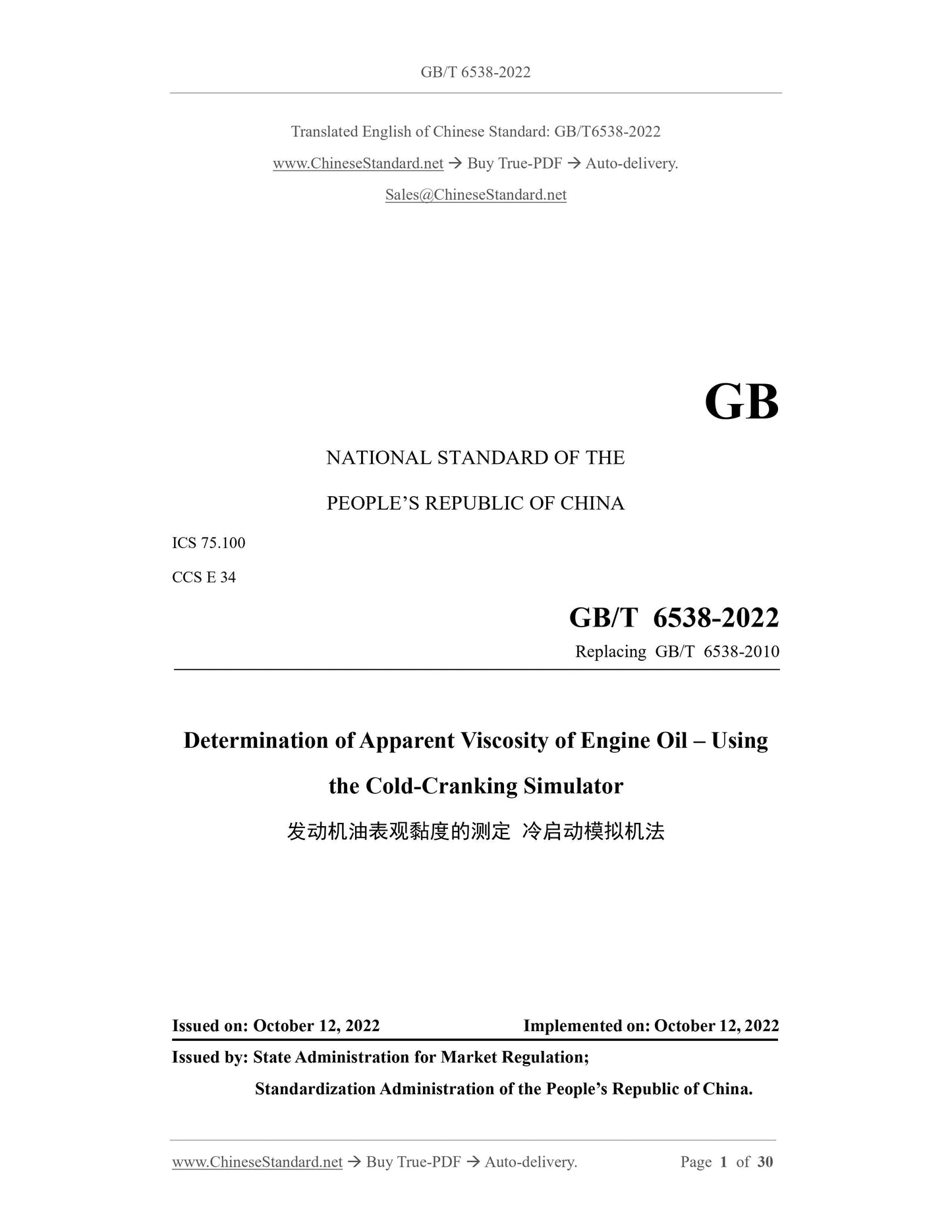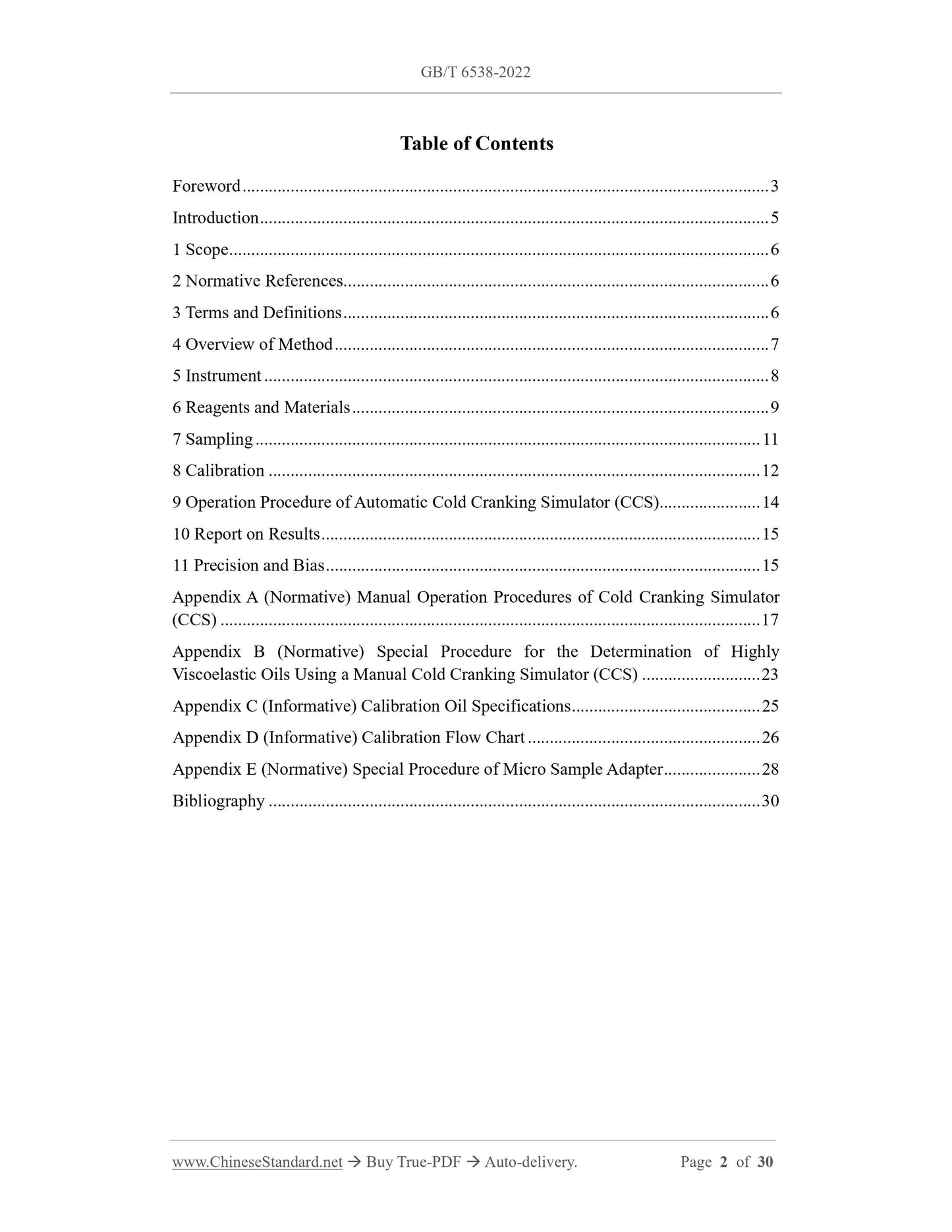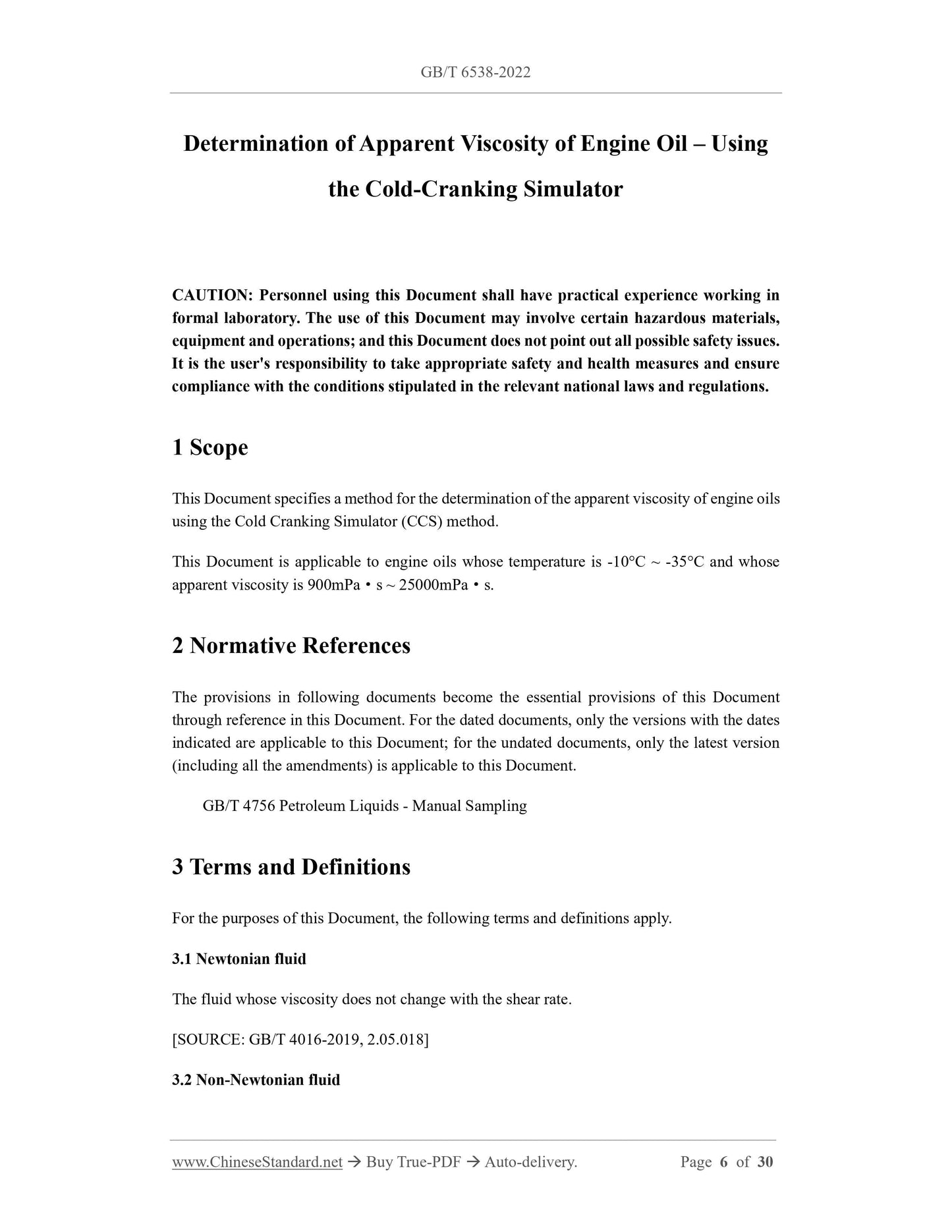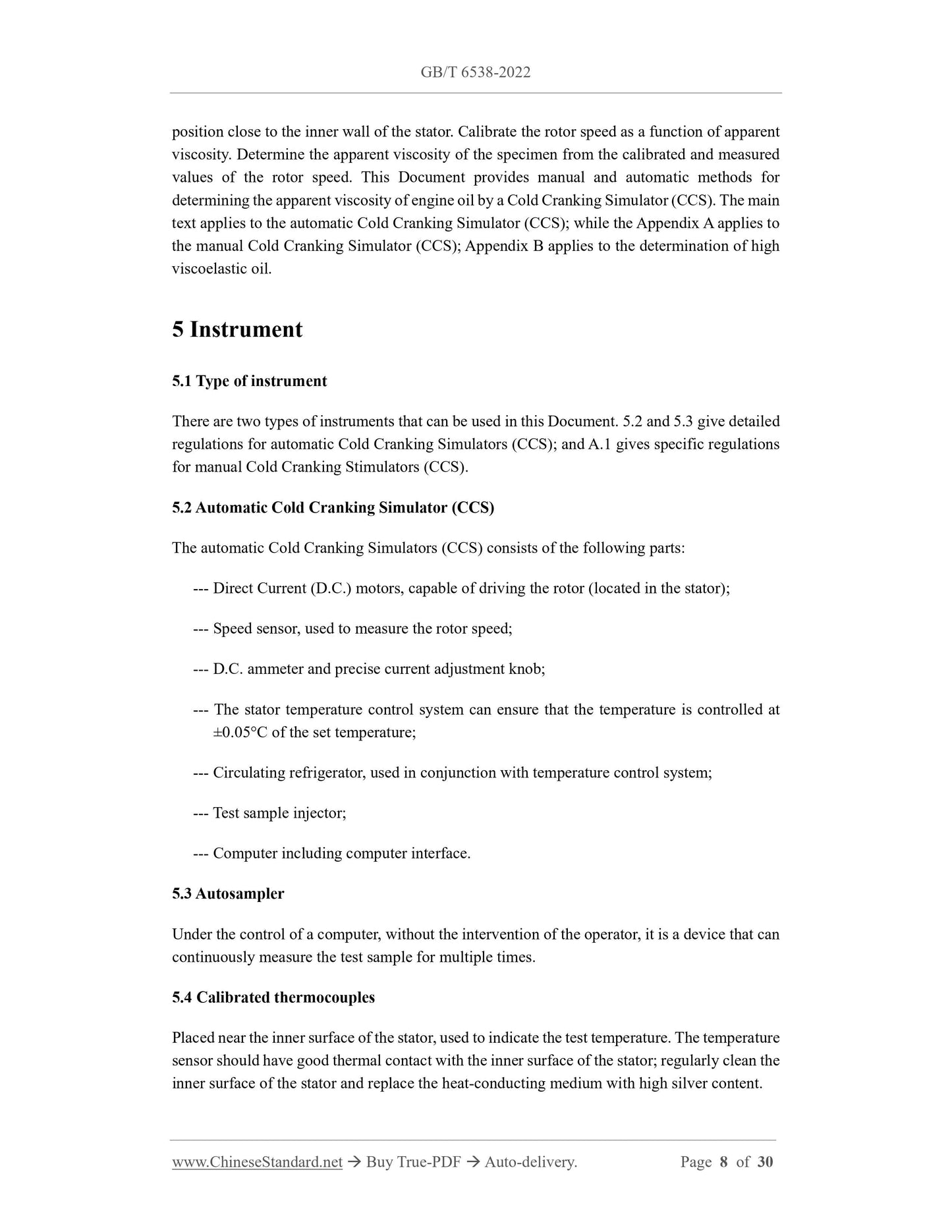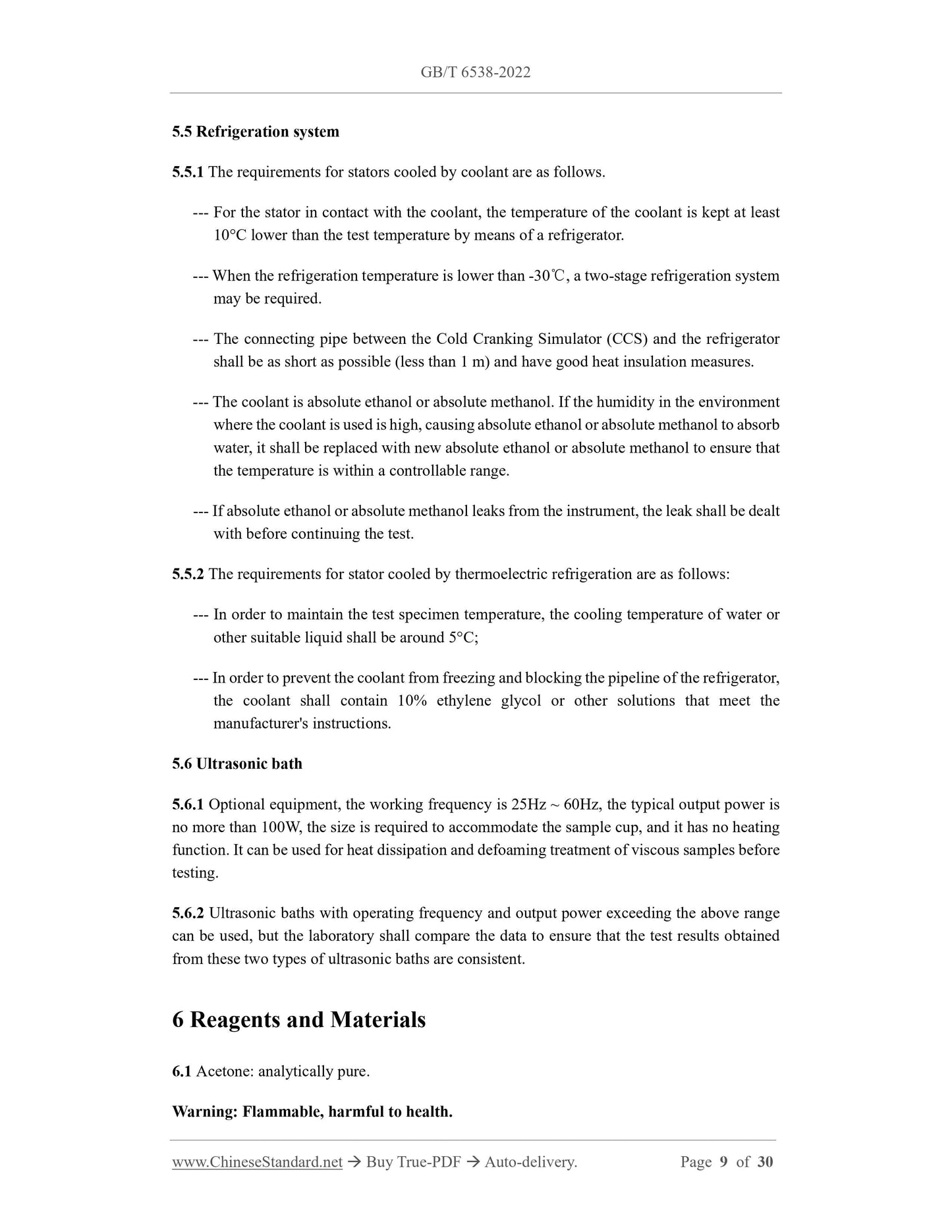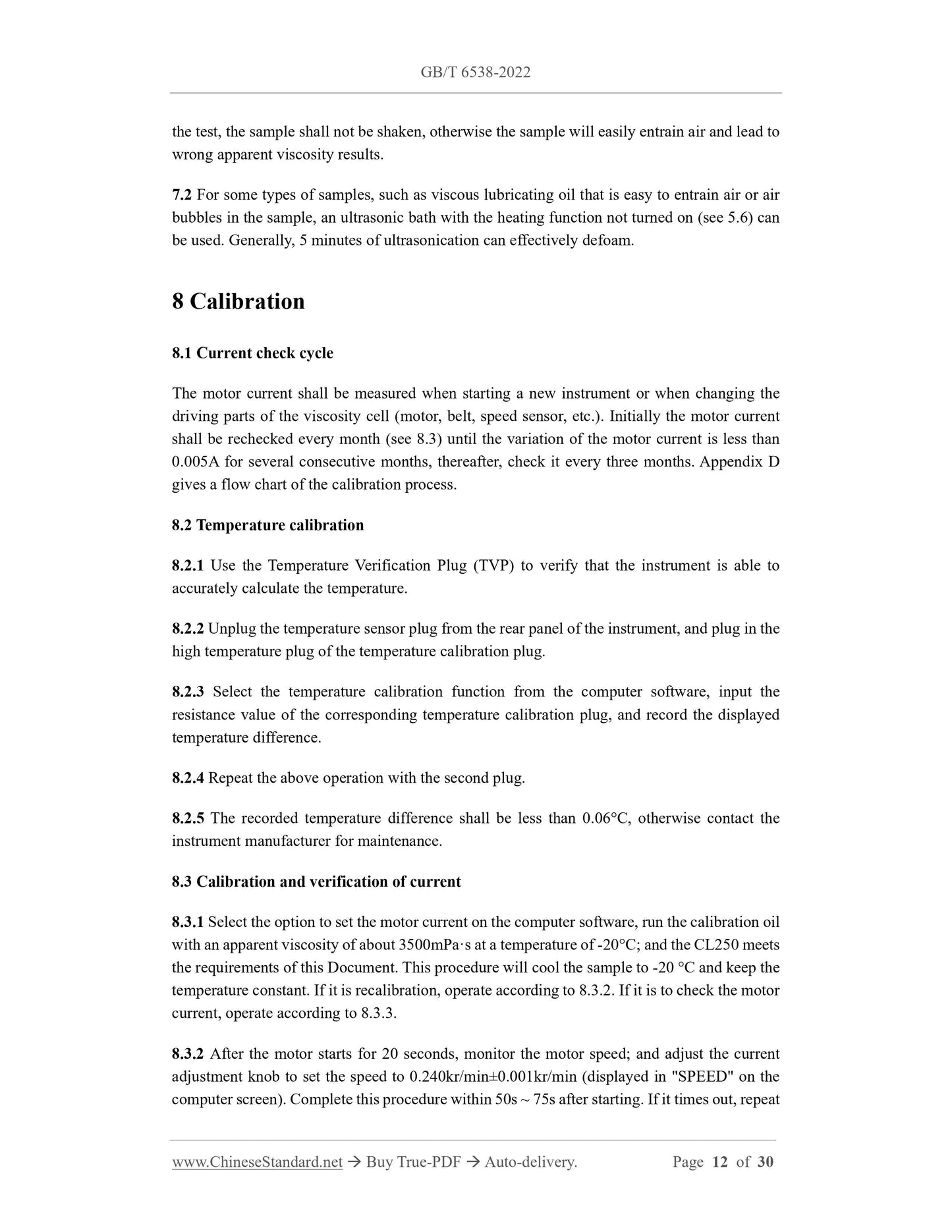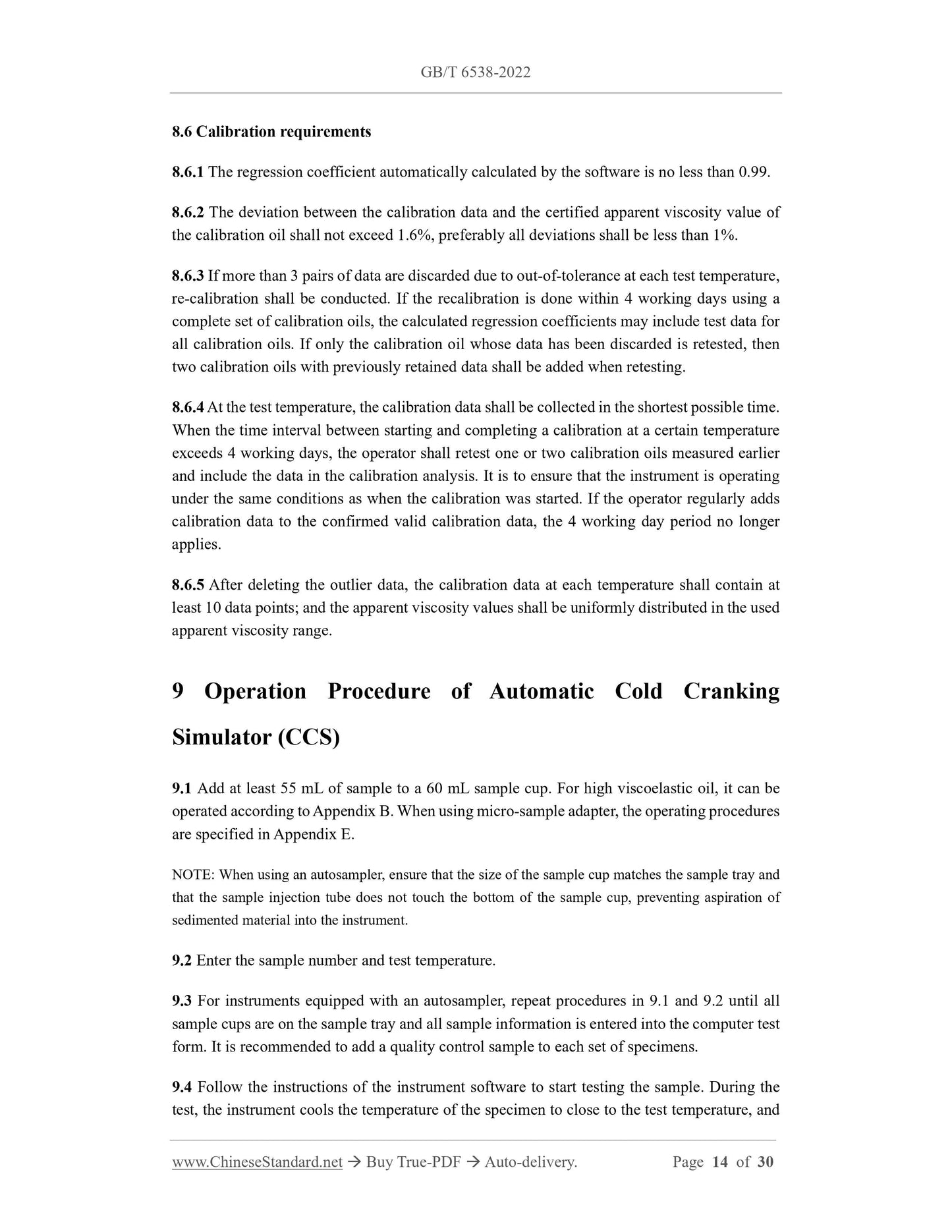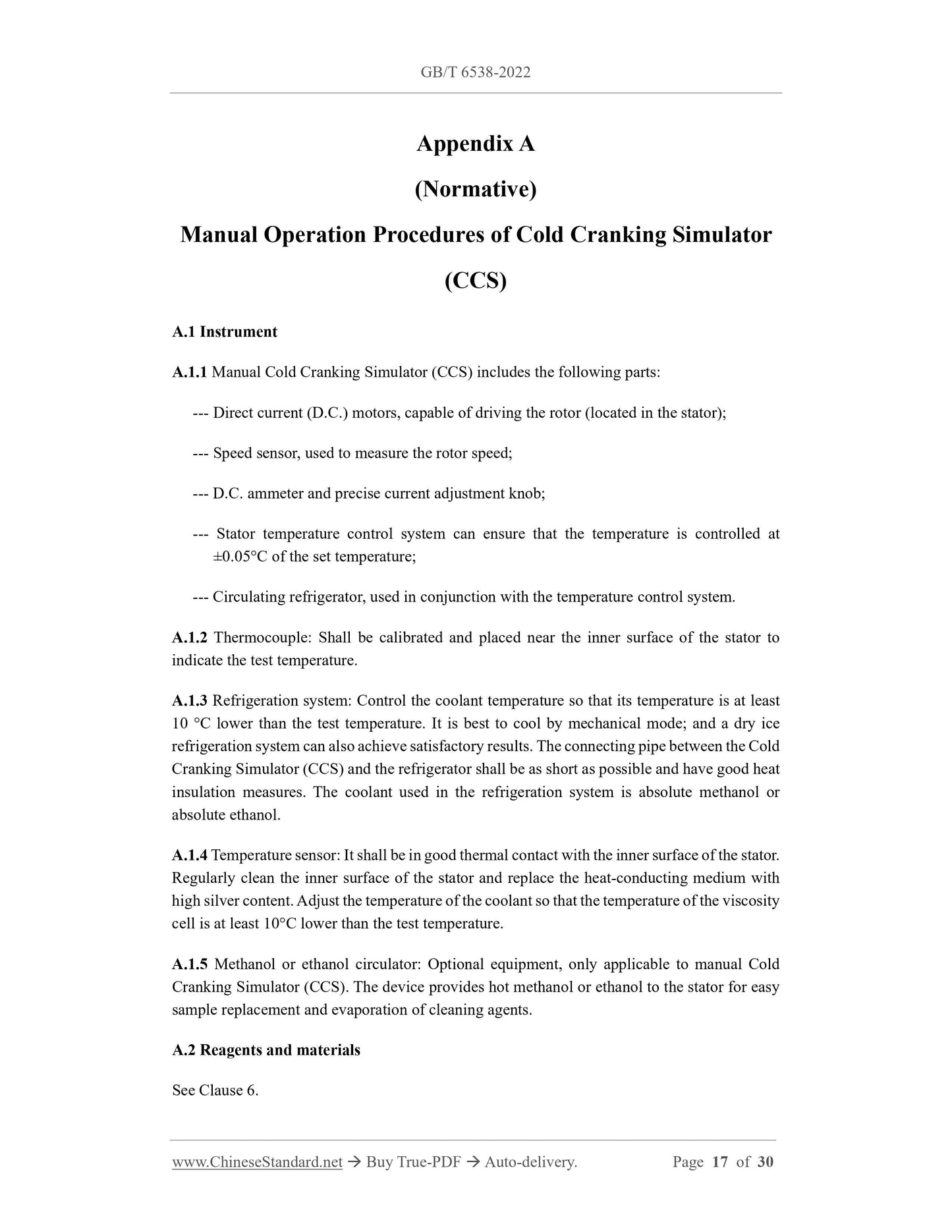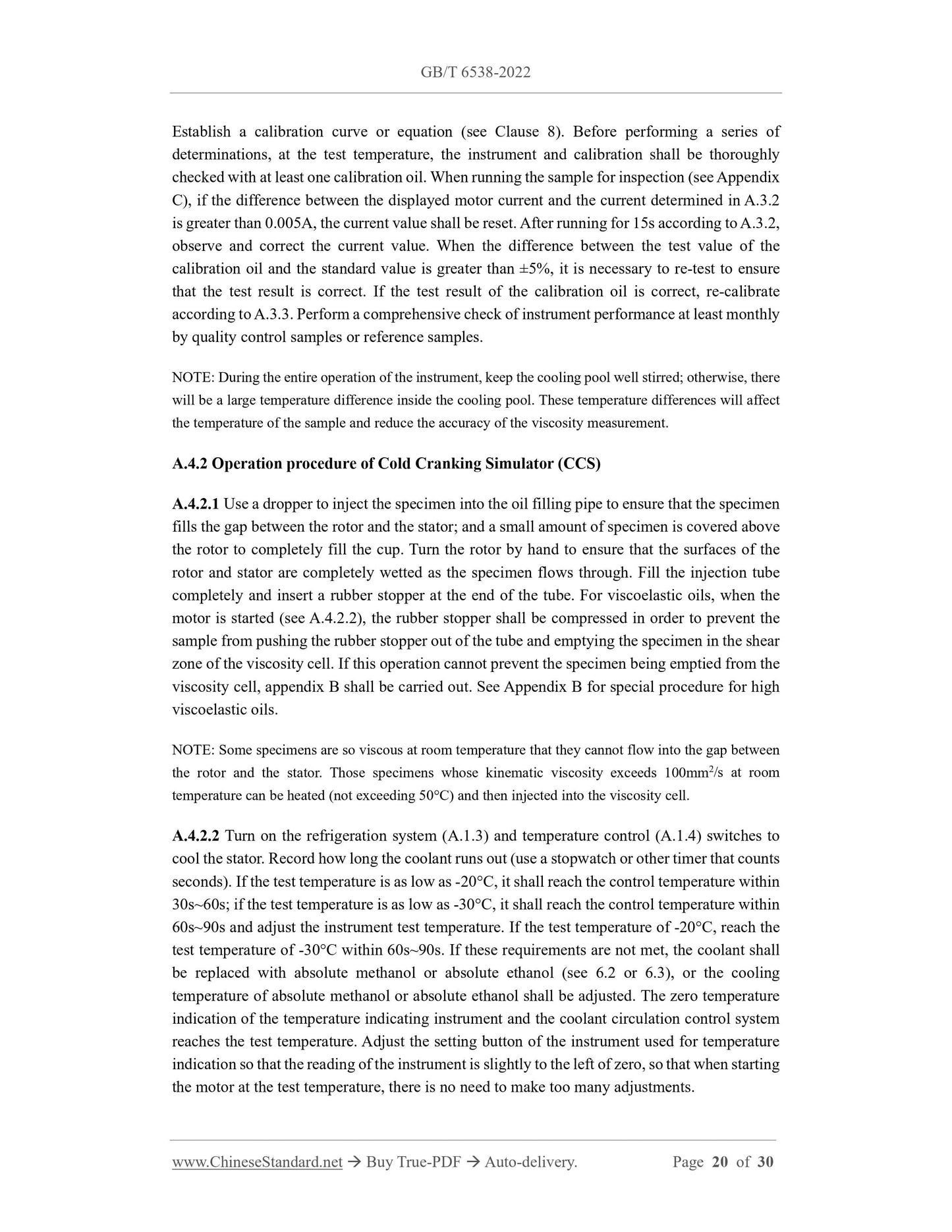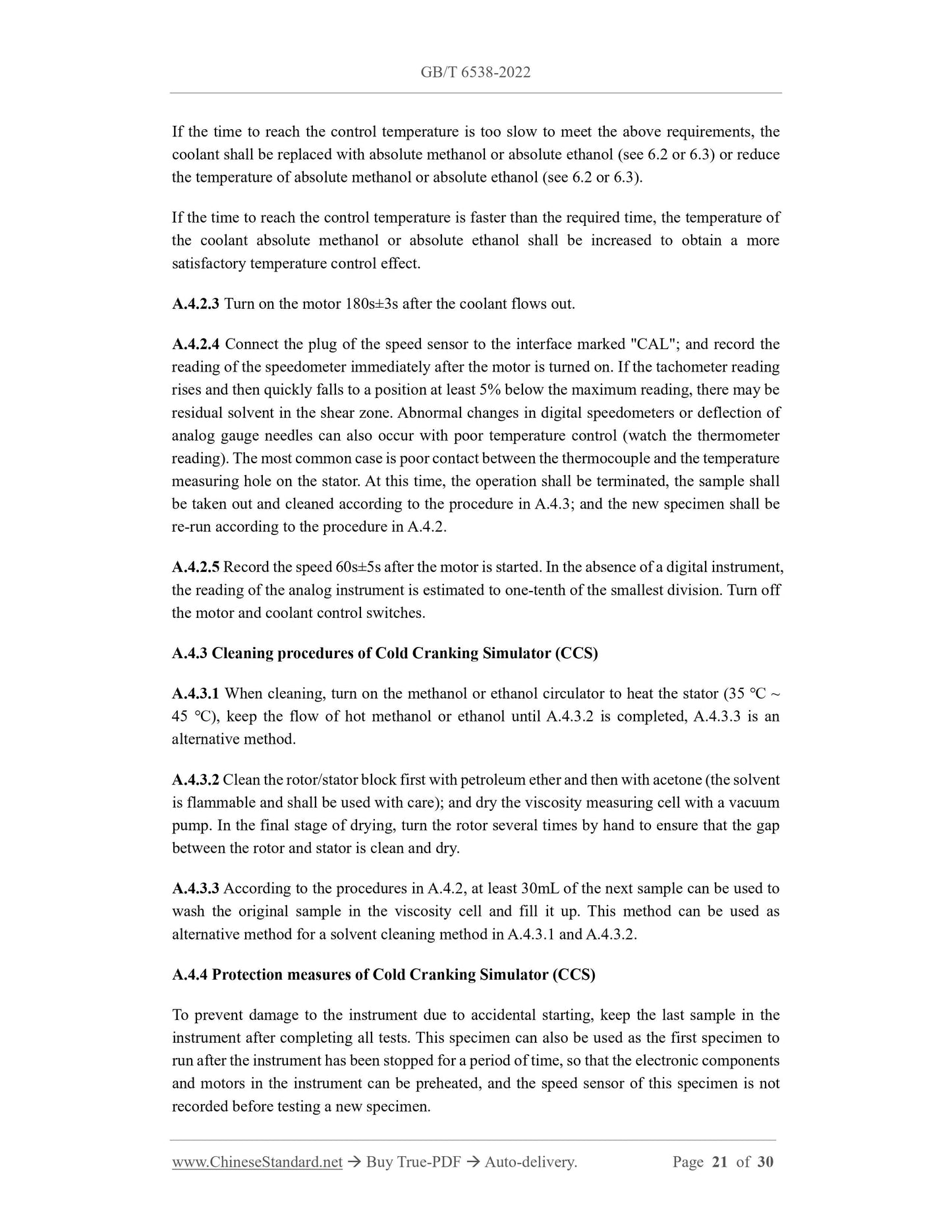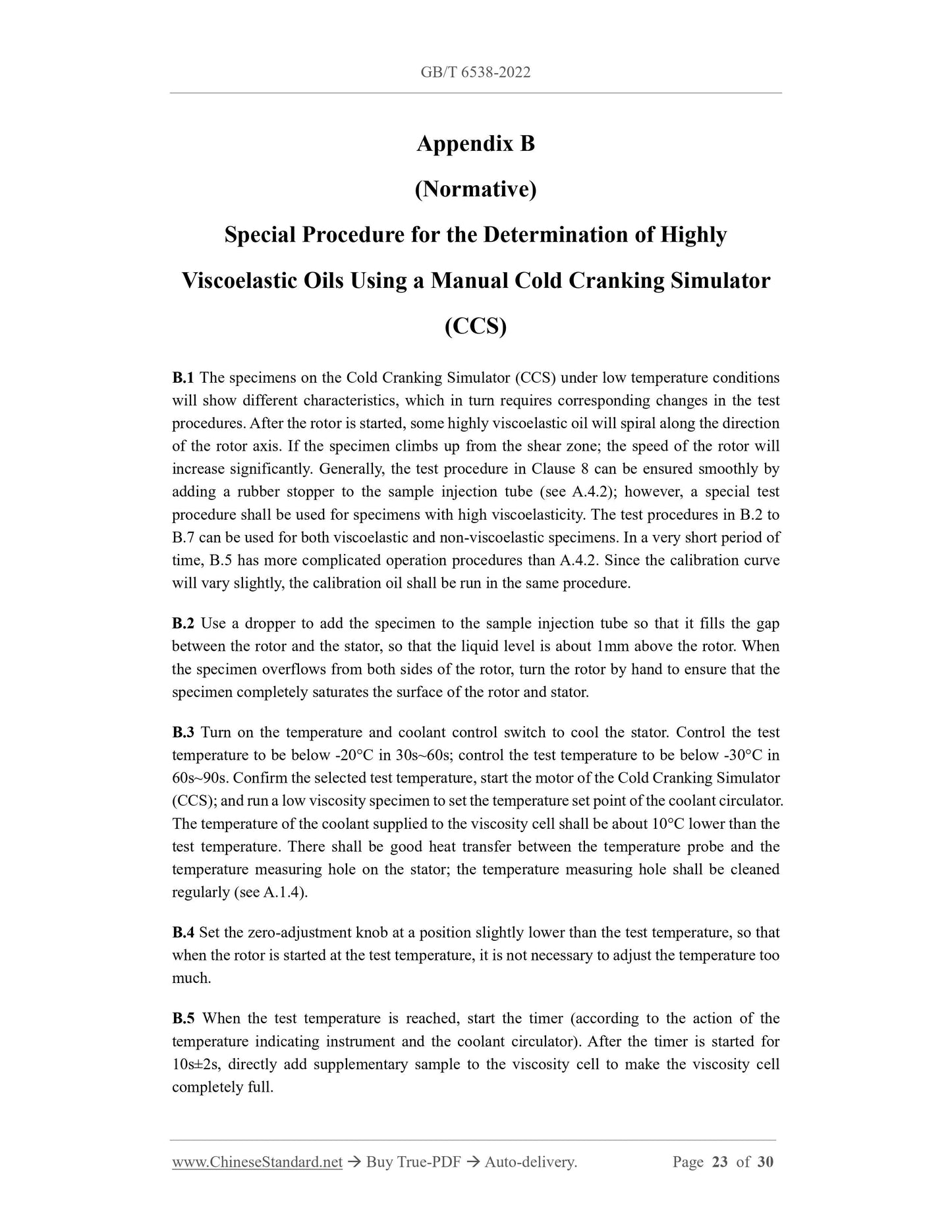1
/
of
12
www.ChineseStandard.us -- Field Test Asia Pte. Ltd.
GB/T 6538-2022 English PDF (GB/T6538-2022)
GB/T 6538-2022 English PDF (GB/T6538-2022)
Regular price
$290.00
Regular price
Sale price
$290.00
Unit price
/
per
Shipping calculated at checkout.
Couldn't load pickup availability
GB/T 6538-2022: Determination of apparent viscosity of engine oils - Using the cold-cranking simulator
Delivery: 9 seconds. Download (& Email) true-PDF + Invoice.
Get Quotation: Click GB/T 6538-2022 (Self-service in 1-minute)
Historical versions (Master-website): GB/T 6538-2022
Preview True-PDF (Reload/Scroll-down if blank)
GB/T 6538-2022
GB
NATIONAL STANDARD OF THE
PEOPLE’S REPUBLIC OF CHINA
ICS 75.100
CCS E 34
Replacing GB/T 6538-2010
Determination of Apparent Viscosity of Engine Oil – Using
the Cold-Cranking Simulator
ISSUED ON: OCTOBER 12, 2022
IMPLEMENTED ON: OCTOBER 12, 2022
Issued by: State Administration for Market Regulation;
Standardization Administration of the People’s Republic of China.
Table of Contents
Foreword ... 3
Introduction ... 5
1 Scope ... 6
2 Normative References ... 6
3 Terms and Definitions ... 6
4 Overview of Method ... 7
5 Instrument ... 8
6 Reagents and Materials ... 9
7 Sampling ... 11
8 Calibration ... 12
9 Operation Procedure of Automatic Cold Cranking Simulator (CCS) ... 14
10 Report on Results ... 15
11 Precision and Bias ... 15
Appendix A (Normative) Manual Operation Procedures of Cold Cranking Simulator
(CCS) ... 17
Appendix B (Normative) Special Procedure for the Determination of Highly
Viscoelastic Oils Using a Manual Cold Cranking Simulator (CCS) ... 23
Appendix C (Informative) Calibration Oil Specifications ... 25
Appendix D (Informative) Calibration Flow Chart ... 26
Appendix E (Normative) Special Procedure of Micro Sample Adapter ... 28
Bibliography ... 30
Determination of Apparent Viscosity of Engine Oil – Using
the Cold-Cranking Simulator
CAUTION: Personnel using this Document shall have practical experience working in
formal laboratory. The use of this Document may involve certain hazardous materials,
equipment and operations; and this Document does not point out all possible safety issues.
It is the user's responsibility to take appropriate safety and health measures and ensure
compliance with the conditions stipulated in the relevant national laws and regulations.
1 Scope
This Document specifies a method for the determination of the apparent viscosity of engine oils
using the Cold Cranking Simulator (CCS) method.
This Document is applicable to engine oils whose temperature is -10°C ~ -35°C and whose
apparent viscosity is 900mPa·s ~ 25000mPa·s.
2 Normative References
The provisions in following documents become the essential provisions of this Document
through reference in this Document. For the dated documents, only the versions with the dates
indicated are applicable to this Document; for the undated documents, only the latest version
(including all the amendments) is applicable to this Document.
GB/T 4756 Petroleum Liquids - Manual Sampling
3 Terms and Definitions
For the purposes of this Document, the following terms and definitions apply.
3.1 Newtonian fluid
The fluid whose viscosity does not change with the shear rate.
[SOURCE: GB/T 4016-2019, 2.05.018]
3.2 Non-Newtonian fluid
position close to the inner wall of the stator. Calibrate the rotor speed as a function of apparent
viscosity. Determine the apparent viscosity of the specimen from the calibrated and measured
values of the rotor speed. This Document provides manual and automatic methods for
determining the apparent viscosity of engine oil by a Cold Cranking Simulator (CCS). The main
text applies to the automatic Cold Cranking Simulator (CCS); while the Appendix A applies to
the manual Cold Cranking Simulator (CCS); Appendix B applies to the determination of high
viscoelastic oil.
5 Instrument
5.1 Type of instrument
There are two types of instruments that can be used in this Document. 5.2 and 5.3 give detailed
regulations for automatic Cold Cranking Simulators (CCS); and A.1 gives specific regulations
for manual Cold Cranking Stimulators (CCS).
5.2 Automatic Cold Cranking Simulator (CCS)
The automatic Cold Cranking Simulators (CCS) consists of the following parts:
--- Direct Current (D.C.) motors, capable of driving the rotor (located in the stator);
--- Speed sensor, used to measure the rotor speed;
--- D.C. ammeter and precise current adjustment knob;
--- The stator temperature control system can ensure that the temperature is controlled at
±0.05°C of the set temperature;
--- Circulating refrigerator, used in conjunction with temperature control system;
--- Test sample injector;
--- Computer including computer interface.
5.3 Autosampler
Under the control of a computer, without the intervention of the operator, it is a device that can
continuously measure the test sample for multiple times.
5.4 Calibrated thermocouples
Placed near the inner surface of the stator, used to indicate the test temperature. The temperature
sensor should have good thermal contact with the inner surface of the stator; regularly clean the
inner surface of the stator and replace the heat-conducting medium with high silver content.
5.5 Refrigeration system
5.5.1 The requirements for stators cooled by coolant are as follows.
--- For the stator in contact with the coolant, the temperature of the coolant is kept at least
10°C lower than the test temperature by means of a refrigerator.
--- When the refrigeration temperature is lower than -30℃, a two-stage refrigeration system
may be required.
--- The connecting pipe between the Cold Cranking Simulator (CCS) and the refrigerator
shall be as short as possible (less than 1 m) and have good heat insulation measures.
--- The coolant is absolute ethanol or absolute methanol. If the humidity in the environment
where the coolant is used is high, causing absolute ethanol or absolute methanol to absorb
water, it shall be replaced with new absolute ethanol or absolute methanol to ensure that
the temperature is within a controllable range.
--- If absolute ethanol or absolute methanol leaks from the instrument, the leak shall be dealt
with before continuing the test.
5.5.2 The requirements for stator cooled by thermoelectric refrigeration are as follows:
--- In order to maintain the test specimen temperature, the cooling temperature of water or
other suitable liquid shall be around 5°C;
--- In order to prevent the coolant from freezing and blocking the pipeline of the refrigerator,
the coolant shall contain 10% ethylene glycol or other solutions that meet the
manufacturer's instructions.
5.6 Ultrasonic bath
5.6.1 Optional equipment, the working frequency is 25Hz ~ 60Hz, the typical output power is
no more than 100W, the size is required to accommodate the sample cup, and it has no heating
function. It can be used for heat dissipation and defoaming treatment of viscous samples before
testing.
5.6.2 Ultrasonic baths with operating frequency and output power exceeding the above range
can be used, but the laboratory shall compare the data to ensure that the test results obtained
from these two types of ultrasonic baths are consistent.
6 Reagents and Materials
6.1 Acetone: analytically pure.
Warning: Flammable, harmful to health.
the test, the sample shall not be shaken, otherwise the sample will easily entrain air and lead to
wrong apparent viscosity results.
7.2 For some types of samples, such as viscous lubricating oil that is easy to entrain air or air
bubbles in the sample, an ultrasonic bath with the heating function not turned on (see 5.6) can
be used. Generally, 5 minutes of ultrasonication can effectively defoam.
8 Calibration
8.1 Current check cycle
The motor current shall be measured when starting a new instrument or when changing the
driving parts of the viscosity cell (motor, belt, speed sensor, etc.). Initially the motor current
shall be rechecked every month (see 8.3) until the variation of the motor current is less than
0.005A for several consecutive months, thereafter, check it every three months. Appendix D
gives a flow chart of the calibration process.
8.2 Temperature calibration
8.2.1 Use the Temperature Verification Plug (TVP) to verify that the instrument is able to
accurately calculate the temperature.
8.2.2 Unplug the temperature sensor plug from the rear panel of the instrument, and plug in the
high temperature plug of the temperature calibration plug.
8.2.3 Select the temperature calibration function from the computer software, input the
resistance value of the corresponding temperature calibration plug, and record the displayed
temperature difference.
8.2.4 Repeat the above operation with the second plug.
8.2.5 The recorded temperature difference shall be less than 0.06°C, otherwise contact the
instrument manufacturer for maintenance.
8.3 Calibration and verification of current
8.3.1 Select the option to set the motor current on the computer software, run the calibration oil
with an apparent viscosity of about 3500mPa·s at a temperature of -20°C; and the CL250 meets
the requirements of this Document. This procedure will cool the sample to -20 °C and keep the
temperature constant. If it is recalibration, operate according to 8.3.2. If it is to check the motor
current, operate according to 8.3.3.
8.3.2 After the motor starts for 20 seconds, monitor the motor speed; and adjust the current
adjustment knob to set the speed to 0.240kr/min±0.001kr/min (displayed in "SPEED" on the
computer screen). Complete this procedure within 50s ~ 75s after starting. If it times out, repeat
8.6 Calibration requirements
8.6.1 The regression coefficient automatically calculated by the software is no less than 0.99.
8.6.2 The deviation between the calibration data and the certified apparent viscosity value of
the calibration oil shall not exceed 1.6%, preferably all deviations shall be less than 1%.
8.6.3 If more than 3 pairs of data are discarded due to out-of-tolerance at each test temperature,
re-calibration shall be conducted. If the recalibration is done within 4 working days using a
complete set of calibration oils, the calculated regression coefficients may include test data for
all calibration oils. If only the calibration oil whose data has been discarded is retested, then
two calibration oils with previously retained data shall be added when retesting.
8.6.4 At the test temperature, the calibration data shall be collected in the shortest possible time.
When the time interval between starting and completing a calibration at a certain temperature
exceeds 4 working days, the operator shall retest one or two calibration oils measured earlier
and include the data in the calibration analysis. It is to ensure that the instrument is operating
under the same conditions as when the calibration was started. If the operator regularly adds
calibration data to the confirmed valid calibration data, the 4 working day period no longer
applies.
8.6.5 After deleting the outlier data, the calibration data at each temperature shall contain at
least 10 data points; and the apparent viscosity values shall be uniformly distributed in the used
apparent viscosity range.
9 Operation Procedure of Automatic Cold Cranking
Simulator (CCS)
9.1 Add at least 55 mL of sample to a 60 mL sample cup. For high viscoelastic oil, it can be
operated according to Appendix B. When using micro-sample adapter, the operating procedures
are specified in Appendix E.
NOTE: When using an autosampler, ensure that the size of the sample cup matches the sample tray and
that the sample injection tube does not touch the bottom of the sample cup, preventing aspiration of
sedimented material into the instrument.
9.2 Enter the sample number and test temperature.
9.3 For instruments equipped with an autosampler, repeat procedures in 9.1 and 9.2 until all
sample cups are on the sample tray and all sample information is entered into the computer test
form. It is recommended to add a quality control sample to each set of specimens.
9.4 Follow the instructions of the instrument software to start testing the sample. During the
test, the instrument cools the temperature of the specimen to close to the test temperature, and
keeps the temperature constant for 180s. Then start the motor and record the speed, but only
the average speed of 55s ~ 60s is used to calculate the apparent viscosity.
NOTE: The new specimen will automatically replace the previous specimen, no solvent cleaning is
required. Both temperature and motor operation are computer controlled. The measurement of the motor
speed and the calculation of the apparent viscosity of the specimen are executed and displayed by the
computer.
9.5 If the difference between the test results of the quality control samples and the expected
value exceeds the reproducibility range of this Document, the test results of this group of
samples are suspicious. If two consecutive sets of results are suspicious, recheck the rotor speed
by calibration oil CL250 at -20°C. If the rotor speed exceeds 0.240kr/min±0.005kr/min, find
and solve the cause of the deviation, and recalibrate.
10 Report on Results
Report the apparent viscosity and temperature displayed on the computer monitor.
11 Precision and Bias
11.1 Overview
The precision of this Document is obtained from the statistics of samples with a measurement
temperature of -20°C ~ -35°C and an apparent viscosity of 2700mPa·s ~ 15000mPa·s. Judge
the reliability of the test results (95% confidence level) according to the provisions of 11.2 and
11.3.
NOTE: The precision of this document is obtained through statistical calculation by the CCS-
4/5 instrument with version 4.X or higher software (coolant cooling) and the CCS-2050/2100
instrument equipped with ViscPro CCS software (thermoelectric cooling). The temperature
range of the test sample is -20 ℃ ~ -35 ℃; and the apparent viscosity range is 2700mPa·s ~
15000mPa·s.
11.2 Repeatability (r)
The difference between two consecutive test results obtained by the same operator in the same
laboratory, using the same instrument and the same method to measure the same sample shall
not exceed the repeatability limit specified in Table 2.
11.3 Reproducibility (R)
The difference between two single, independent test results obtained by different operators in
different laboratories, using different instruments and the same method to measure the same
sample separately shall not exceed the reproducibility limits specified in Table 2.
Appendix A
(Normative)
Manual Operation Procedures of Co...
Delivery: 9 seconds. Download (& Email) true-PDF + Invoice.
Get Quotation: Click GB/T 6538-2022 (Self-service in 1-minute)
Historical versions (Master-website): GB/T 6538-2022
Preview True-PDF (Reload/Scroll-down if blank)
GB/T 6538-2022
GB
NATIONAL STANDARD OF THE
PEOPLE’S REPUBLIC OF CHINA
ICS 75.100
CCS E 34
Replacing GB/T 6538-2010
Determination of Apparent Viscosity of Engine Oil – Using
the Cold-Cranking Simulator
ISSUED ON: OCTOBER 12, 2022
IMPLEMENTED ON: OCTOBER 12, 2022
Issued by: State Administration for Market Regulation;
Standardization Administration of the People’s Republic of China.
Table of Contents
Foreword ... 3
Introduction ... 5
1 Scope ... 6
2 Normative References ... 6
3 Terms and Definitions ... 6
4 Overview of Method ... 7
5 Instrument ... 8
6 Reagents and Materials ... 9
7 Sampling ... 11
8 Calibration ... 12
9 Operation Procedure of Automatic Cold Cranking Simulator (CCS) ... 14
10 Report on Results ... 15
11 Precision and Bias ... 15
Appendix A (Normative) Manual Operation Procedures of Cold Cranking Simulator
(CCS) ... 17
Appendix B (Normative) Special Procedure for the Determination of Highly
Viscoelastic Oils Using a Manual Cold Cranking Simulator (CCS) ... 23
Appendix C (Informative) Calibration Oil Specifications ... 25
Appendix D (Informative) Calibration Flow Chart ... 26
Appendix E (Normative) Special Procedure of Micro Sample Adapter ... 28
Bibliography ... 30
Determination of Apparent Viscosity of Engine Oil – Using
the Cold-Cranking Simulator
CAUTION: Personnel using this Document shall have practical experience working in
formal laboratory. The use of this Document may involve certain hazardous materials,
equipment and operations; and this Document does not point out all possible safety issues.
It is the user's responsibility to take appropriate safety and health measures and ensure
compliance with the conditions stipulated in the relevant national laws and regulations.
1 Scope
This Document specifies a method for the determination of the apparent viscosity of engine oils
using the Cold Cranking Simulator (CCS) method.
This Document is applicable to engine oils whose temperature is -10°C ~ -35°C and whose
apparent viscosity is 900mPa·s ~ 25000mPa·s.
2 Normative References
The provisions in following documents become the essential provisions of this Document
through reference in this Document. For the dated documents, only the versions with the dates
indicated are applicable to this Document; for the undated documents, only the latest version
(including all the amendments) is applicable to this Document.
GB/T 4756 Petroleum Liquids - Manual Sampling
3 Terms and Definitions
For the purposes of this Document, the following terms and definitions apply.
3.1 Newtonian fluid
The fluid whose viscosity does not change with the shear rate.
[SOURCE: GB/T 4016-2019, 2.05.018]
3.2 Non-Newtonian fluid
position close to the inner wall of the stator. Calibrate the rotor speed as a function of apparent
viscosity. Determine the apparent viscosity of the specimen from the calibrated and measured
values of the rotor speed. This Document provides manual and automatic methods for
determining the apparent viscosity of engine oil by a Cold Cranking Simulator (CCS). The main
text applies to the automatic Cold Cranking Simulator (CCS); while the Appendix A applies to
the manual Cold Cranking Simulator (CCS); Appendix B applies to the determination of high
viscoelastic oil.
5 Instrument
5.1 Type of instrument
There are two types of instruments that can be used in this Document. 5.2 and 5.3 give detailed
regulations for automatic Cold Cranking Simulators (CCS); and A.1 gives specific regulations
for manual Cold Cranking Stimulators (CCS).
5.2 Automatic Cold Cranking Simulator (CCS)
The automatic Cold Cranking Simulators (CCS) consists of the following parts:
--- Direct Current (D.C.) motors, capable of driving the rotor (located in the stator);
--- Speed sensor, used to measure the rotor speed;
--- D.C. ammeter and precise current adjustment knob;
--- The stator temperature control system can ensure that the temperature is controlled at
±0.05°C of the set temperature;
--- Circulating refrigerator, used in conjunction with temperature control system;
--- Test sample injector;
--- Computer including computer interface.
5.3 Autosampler
Under the control of a computer, without the intervention of the operator, it is a device that can
continuously measure the test sample for multiple times.
5.4 Calibrated thermocouples
Placed near the inner surface of the stator, used to indicate the test temperature. The temperature
sensor should have good thermal contact with the inner surface of the stator; regularly clean the
inner surface of the stator and replace the heat-conducting medium with high silver content.
5.5 Refrigeration system
5.5.1 The requirements for stators cooled by coolant are as follows.
--- For the stator in contact with the coolant, the temperature of the coolant is kept at least
10°C lower than the test temperature by means of a refrigerator.
--- When the refrigeration temperature is lower than -30℃, a two-stage refrigeration system
may be required.
--- The connecting pipe between the Cold Cranking Simulator (CCS) and the refrigerator
shall be as short as possible (less than 1 m) and have good heat insulation measures.
--- The coolant is absolute ethanol or absolute methanol. If the humidity in the environment
where the coolant is used is high, causing absolute ethanol or absolute methanol to absorb
water, it shall be replaced with new absolute ethanol or absolute methanol to ensure that
the temperature is within a controllable range.
--- If absolute ethanol or absolute methanol leaks from the instrument, the leak shall be dealt
with before continuing the test.
5.5.2 The requirements for stator cooled by thermoelectric refrigeration are as follows:
--- In order to maintain the test specimen temperature, the cooling temperature of water or
other suitable liquid shall be around 5°C;
--- In order to prevent the coolant from freezing and blocking the pipeline of the refrigerator,
the coolant shall contain 10% ethylene glycol or other solutions that meet the
manufacturer's instructions.
5.6 Ultrasonic bath
5.6.1 Optional equipment, the working frequency is 25Hz ~ 60Hz, the typical output power is
no more than 100W, the size is required to accommodate the sample cup, and it has no heating
function. It can be used for heat dissipation and defoaming treatment of viscous samples before
testing.
5.6.2 Ultrasonic baths with operating frequency and output power exceeding the above range
can be used, but the laboratory shall compare the data to ensure that the test results obtained
from these two types of ultrasonic baths are consistent.
6 Reagents and Materials
6.1 Acetone: analytically pure.
Warning: Flammable, harmful to health.
the test, the sample shall not be shaken, otherwise the sample will easily entrain air and lead to
wrong apparent viscosity results.
7.2 For some types of samples, such as viscous lubricating oil that is easy to entrain air or air
bubbles in the sample, an ultrasonic bath with the heating function not turned on (see 5.6) can
be used. Generally, 5 minutes of ultrasonication can effectively defoam.
8 Calibration
8.1 Current check cycle
The motor current shall be measured when starting a new instrument or when changing the
driving parts of the viscosity cell (motor, belt, speed sensor, etc.). Initially the motor current
shall be rechecked every month (see 8.3) until the variation of the motor current is less than
0.005A for several consecutive months, thereafter, check it every three months. Appendix D
gives a flow chart of the calibration process.
8.2 Temperature calibration
8.2.1 Use the Temperature Verification Plug (TVP) to verify that the instrument is able to
accurately calculate the temperature.
8.2.2 Unplug the temperature sensor plug from the rear panel of the instrument, and plug in the
high temperature plug of the temperature calibration plug.
8.2.3 Select the temperature calibration function from the computer software, input the
resistance value of the corresponding temperature calibration plug, and record the displayed
temperature difference.
8.2.4 Repeat the above operation with the second plug.
8.2.5 The recorded temperature difference shall be less than 0.06°C, otherwise contact the
instrument manufacturer for maintenance.
8.3 Calibration and verification of current
8.3.1 Select the option to set the motor current on the computer software, run the calibration oil
with an apparent viscosity of about 3500mPa·s at a temperature of -20°C; and the CL250 meets
the requirements of this Document. This procedure will cool the sample to -20 °C and keep the
temperature constant. If it is recalibration, operate according to 8.3.2. If it is to check the motor
current, operate according to 8.3.3.
8.3.2 After the motor starts for 20 seconds, monitor the motor speed; and adjust the current
adjustment knob to set the speed to 0.240kr/min±0.001kr/min (displayed in "SPEED" on the
computer screen). Complete this procedure within 50s ~ 75s after starting. If it times out, repeat
8.6 Calibration requirements
8.6.1 The regression coefficient automatically calculated by the software is no less than 0.99.
8.6.2 The deviation between the calibration data and the certified apparent viscosity value of
the calibration oil shall not exceed 1.6%, preferably all deviations shall be less than 1%.
8.6.3 If more than 3 pairs of data are discarded due to out-of-tolerance at each test temperature,
re-calibration shall be conducted. If the recalibration is done within 4 working days using a
complete set of calibration oils, the calculated regression coefficients may include test data for
all calibration oils. If only the calibration oil whose data has been discarded is retested, then
two calibration oils with previously retained data shall be added when retesting.
8.6.4 At the test temperature, the calibration data shall be collected in the shortest possible time.
When the time interval between starting and completing a calibration at a certain temperature
exceeds 4 working days, the operator shall retest one or two calibration oils measured earlier
and include the data in the calibration analysis. It is to ensure that the instrument is operating
under the same conditions as when the calibration was started. If the operator regularly adds
calibration data to the confirmed valid calibration data, the 4 working day period no longer
applies.
8.6.5 After deleting the outlier data, the calibration data at each temperature shall contain at
least 10 data points; and the apparent viscosity values shall be uniformly distributed in the used
apparent viscosity range.
9 Operation Procedure of Automatic Cold Cranking
Simulator (CCS)
9.1 Add at least 55 mL of sample to a 60 mL sample cup. For high viscoelastic oil, it can be
operated according to Appendix B. When using micro-sample adapter, the operating procedures
are specified in Appendix E.
NOTE: When using an autosampler, ensure that the size of the sample cup matches the sample tray and
that the sample injection tube does not touch the bottom of the sample cup, preventing aspiration of
sedimented material into the instrument.
9.2 Enter the sample number and test temperature.
9.3 For instruments equipped with an autosampler, repeat procedures in 9.1 and 9.2 until all
sample cups are on the sample tray and all sample information is entered into the computer test
form. It is recommended to add a quality control sample to each set of specimens.
9.4 Follow the instructions of the instrument software to start testing the sample. During the
test, the instrument cools the temperature of the specimen to close to the test temperature, and
keeps the temperature constant for 180s. Then start the motor and record the speed, but only
the average speed of 55s ~ 60s is used to calculate the apparent viscosity.
NOTE: The new specimen will automatically replace the previous specimen, no solvent cleaning is
required. Both temperature and motor operation are computer controlled. The measurement of the motor
speed and the calculation of the apparent viscosity of the specimen are executed and displayed by the
computer.
9.5 If the difference between the test results of the quality control samples and the expected
value exceeds the reproducibility range of this Document, the test results of this group of
samples are suspicious. If two consecutive sets of results are suspicious, recheck the rotor speed
by calibration oil CL250 at -20°C. If the rotor speed exceeds 0.240kr/min±0.005kr/min, find
and solve the cause of the deviation, and recalibrate.
10 Report on Results
Report the apparent viscosity and temperature displayed on the computer monitor.
11 Precision and Bias
11.1 Overview
The precision of this Document is obtained from the statistics of samples with a measurement
temperature of -20°C ~ -35°C and an apparent viscosity of 2700mPa·s ~ 15000mPa·s. Judge
the reliability of the test results (95% confidence level) according to the provisions of 11.2 and
11.3.
NOTE: The precision of this document is obtained through statistical calculation by the CCS-
4/5 instrument with version 4.X or higher software (coolant cooling) and the CCS-2050/2100
instrument equipped with ViscPro CCS software (thermoelectric cooling). The temperature
range of the test sample is -20 ℃ ~ -35 ℃; and the apparent viscosity range is 2700mPa·s ~
15000mPa·s.
11.2 Repeatability (r)
The difference between two consecutive test results obtained by the same operator in the same
laboratory, using the same instrument and the same method to measure the same sample shall
not exceed the repeatability limit specified in Table 2.
11.3 Reproducibility (R)
The difference between two single, independent test results obtained by different operators in
different laboratories, using different instruments and the same method to measure the same
sample separately shall not exceed the reproducibility limits specified in Table 2.
Appendix A
(Normative)
Manual Operation Procedures of Co...
Share
